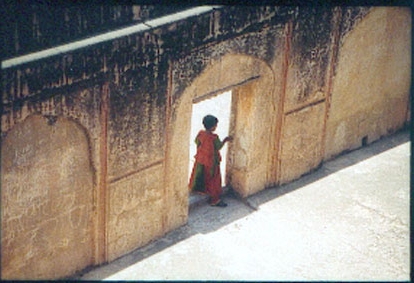





|
India by Emilie Robert and Carlo Tiribelli
India it is not just a physical place, it is before all a mental place. India is a place where reality and fantasy are melted together.
India is a land of contrasts that can not let you indifferent. Its year by year exponential growth of the GDP rate; its glooming dream made of celluloid called Bollywood; its local Silicon Valley called Bangalore, where computer technology is exported at high competitive prices all around the world are examples of a westernized India, an understandable India using the metric of the economic progress. Besides this very important aspects, India has more then 12 million sacred cows strolling around, cows that most of the time nourish them grasping the garbage that abounds anywhere.
Cities are more then chaotic in comparison with any standard of chaos. Besides cows, the roads are fulfilled with donkeys, pigs, monkeys, camels and elephants, whose circulation rights are shared with an enormous quantity of cycles, motorcycles, rickshaws, cars, buses and pedestrians walking along inexistent sidewalks and crisscrossing at any moment the roads. An orgy of honks, shouting and breaking accompanies this undisciplined wave.
Vivid symbols, a never-ending mysticism, a religion that encompasses all the aspects of daily life, a vibrant architecture, an incredible variety of flora and fauna, food mostly designed for vegetarians that makes happy even the pure meat-eaters. The colors of the spices offered by the vendors. A multi-chromatic joy for the eyes and for your camera, a less joy when you taste some of these spices and you turn red while choking.
This is India and nothing of this is India either. Reducing India to its stereotypes is futile. India is so huge, so complex, so extremely rich and so profoundly poor that an accurate description of this country is impossible. Before going to India we were influenced by what we read about it. Rudyard Kipling and Lonely Planet gave us many details and the envy to cast a direct look of this country that does not let you indifferent. Before going to India we trained ourselves with the vision we would have endured when landed over there. Colors and poverty, third world and the biggest call center in the world, archaism and development and some other contrasts. But no book or tourist guide, no referred memory by previous travelers, prepared us to the odors. In our personal opinion, the smell of India is the secret of its beauty and its complexity. Odors are everywhere and they cover everything. Odors in India are are very strong, they do not hide themselves, they render any image even more vivid. The sweetie smell of the open-air flowers markets, the smell of the food cooked any time, anywhere, the smell of the incense, the smell of the animals and the smell of their final phase of digestion, the smell of human bodies carrying other human bodies sitting on the rickshaws or pulling any kind of merchandise, the smell of the humanity confined in overcrowded spaces.
They do not demand to be an all-inclusive image of the whole country; they have been shot in a rather limited area. They do not even demand to be a reliable portrait of all Indian characters. These pictures represent just our intimate idea of this magic land of vivid contrasts. Antwerp-Padova, 10th of March 2005
|
respiro@2000-2004
All rights reserved








